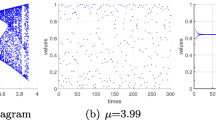Abstract
A color image encryption algorithm by combining the reality-preserving fractional DCT (RPFrDCT) with chaotic mapping in HSI space is presented, in which the generating sequence (GS) is introduced and produced by 2D chaotic mapping to ensure the uniqueness of the transform matrix and enlarge the cipher key space of the encryption system. In addition, the color image is converted from standard RGB space into HSI space and the nonlinearity of the spatial transform makes the proposed encryption algorithm more secure than linear ones. Three components, namely H, S and I, are encrypted by the RPFrDCT with fractional orders and GS as cipher keys. Three-dimensional (3D) scrambling is adopted to further enhance the security of the encryption algorithm. The nonlinearity of the spatial transform from RGB to HSI, the real-valued output and the high cipher key-sensitivity guarantee the security and the feasibility of the proposed encryption algorithm. Experimental results demonstrate that the proposed encryption algorithm is sensitive to cipher keys and, to some extent, robust to noise and occlusion attacks.









Similar content being viewed by others
References
Cariolaro G, Erseghe T, Kraniauskas P (2012) The Fractional discrete cosine transform. IEEE Trans Signal Process 50(4):902–911
Francois M, Grosges T, Barchiesi D, Erra R (2012) A new image encryption scheme based on a chaotic function. Signal Process Image Commun 27(3):249–259
Frauel Y, Castro A, Naughton T, Javidi B (2007) Resistance of the double random phase encryption against various attacks. Opt Express 15(16):10253–10265
Huang XL, Ye GD (2014) An efficient self-adaptive model for chaotic image encryption algorithm. Commun Nonlinear Sci Numer Simul 19(10):4094–4104
Huang XL, Ye GD (2014) An efficient self-adaptive model for chaotic image encryption algorithm. Commun Nonlinear Sci Numer Simul 19(12):4094–4104
Kanso A, Ghebleh M (2012) A novel image encryption algorithm based on a 3D chaotic mapping. Commun Nonlinear Sci Numer Simul 17(7):2943–2959
Lang J (2012) Image encryption based on the reality-preserving multiple-parameter fractional Fourier transform and chaos permutation. Opt Laser Technol 50(7):929–937
Liang YR, Liu GP, Zhou NR, Wu JH (2014) Image encryption combining multiple generating sequences controlled fractional DCT with dependent scrambling and diffusion. J Mod Opt. doi:10.1080/09500340.2014.964342
Liu H, Nan H (2013) Color image security system using chaos-based cyclic shift and multiple-order discrete fractional cosine transform. Opt Laser Technol 50:1–7
Liu S, Sheridan JT (2013) Optical encryption by combining image scrambling techniques in fractional Fourier domains. Opt Commun 287:73–80
Pei SC, Yeh MH (2001) The discrete fractional cosine and sine transforms. IEEE Trans Signal Process 49(6):1198–1207
Refregier P, Javidi B (1995) Optical image encryption based on input plane and Fourier plane random encoding. Opt Lett 20(7):767–769
Singh N, Sinha A (2010) Chaos based multiple image encryption using multiple canonical transforms. Opt Laser Technol 42(5):724–731
Song CY, Qiao YL, Zhang XZ (2013) Image encryption scheme based on new spatiotemporal chaos. Optik 124(18):3329–3334
Tong X (2010) The novel bilateral-Diffusion image encryption algorithm with dynamical compound chaos. J Syst Softw 85(4):850–858
Tong X, Cui M (2009) Image encryption scheme based on 3D baker with dynamical compound chaotic sequence cipher generator. Signal Process 89(4):480–491
Unnikrishnan G, Joseph J, Singh K (2000) Optical encryption by double-random phase encoding in the fractional Fourier domain. Opt Lett 25(12):887–889
Venturini I, Duhamel P (2004) Reality Preserving Fractional Transforms. ICASSP IEEE Int Conf Acoust Speech Signal Process Proc 5:V- 205-V-208
Wu JH, Guo FF, Liang YR, Zhou NR (2014) Triple color images encryption algorithm based on scrambling and the reality-preserving fractional discrete cosine transform. Optik 125(16):4474–4479
Wu JH, Guo FF, Zeng PP, Zhou NR (2013) Image encryption based on a reality-preserving fractional discrete cosine transform and a chaos-based generating sequence. J Mod Opt 60(20):1760–1771
Wu JH, Zhang L, Zhou NR (2010) Image encryption based on the multiple-order discrete fractional cosine transform. Opt Commun 283(9):1720–1725
Yoon JW, Kim H (2010) An image encryption scheme with a pseudorandom permutation based on chaotic mappings. Commun Nonlinear Sci Numer Simul 15(12):3998–4006
Zhang Q, Guo L, Wei XP (2013) A novel image fusion encryption algorithm based on DNA sequence operation and hyper-chaotic system. Optik 124(18):3596–3600
Zhang LY, Hu XB, Liu YS, Wong KW, Gan J (2014) A chaotic image encryption scheme owning temp-value feedback. Commun Nonlinear Sci Numer Simul 19:3653–3659
Zhang YS, Xiao D (2014) Self-adaptive permutation and combined global diffusion for chaotic color image encryption. AEU Int J Electron Commun 68(4):361–368
Zhang YS, Xiao D, Wen WY, Tian Y (2013) Edge-based lightweight image encryption using chaos-based reversible hidden transform and multiple-order discrete fractional cosine transform. Opt Laser Technol 54:1–6
Zhou YC, Chen BL, CLP (2013) Image encryption using a new parametric switching chaotic system. Signal Process 93(11):3039–3052
Zhou NR, Liu XB, Zhang Y, Yang YX (2013) Image encryption scheme based on fractional Mellin transform and phase retrieval technique in fractional Fourier domain. Opt Laser Technol 47:341–346
Zhou NR, Wang YX, Gong LH, Chen XB, Yang YX (2012) Novel color image encryption algorithm based on the reality preserving fractional Mellin transform. Opt Laser Technol 44(7):2270–2281
Acknowledgments
This work was supported by the National Natural Science Foundation of China (61262084 and 61462061), the Natural Science Foundation of Jiangxi Province (20122BAB201029) and the Science and Technology Program of Jiangxi Provincial Department of Education (GJJ14135).
Author information
Authors and Affiliations
Corresponding author
Rights and permissions
About this article
Cite this article
Liang, Y., Liu, G., Zhou, N. et al. Color image encryption combining a reality-preserving fractional DCT with chaotic mapping in HSI space. Multimed Tools Appl 75, 6605–6620 (2016). https://doi.org/10.1007/s11042-015-2592-7
Received:
Revised:
Accepted:
Published:
Issue Date:
DOI: https://doi.org/10.1007/s11042-015-2592-7




